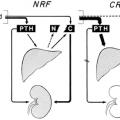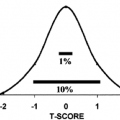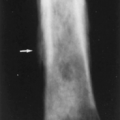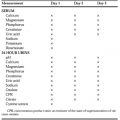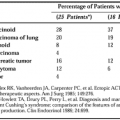PARATHYROID AUTOTRANSPLANTATION
Clinical circumstances in which parathyroid autotransplantation is useful include radical thyroid surgery with either unavoidable or inadvertent devascularization of parathyroid tissue, renal osteodystrophy, primary parathyroid hyperplasia, and repeat surgery for recurrent or persistent hyperparathyroidism. The decision to autotransplant parathyroid tissue depends on the individual patient.
In the case of inadvertent devascularization of normal parathyroid tissue, such as during radical thyroid surgery, immediate autotransplantation is indicated. The devascularized gland is removed and placed in cold saline. A frozen section is obtained to confirm that the tissue is parathyroid. After thyroidectomy, the parathyroid tissue is sliced into 1-mm × 3-mm slivers and immediately implanted into the sternocleidomas-toid muscle. Each implantation site contains one or two parathyroid fragments and is marked with a silk suture. Some investigators question the need to perform this technique if other in situ parathyroid glands appear viable. However, assessing viability by macroscopic appearance is difficult. If any question exists regarding adequacy of the blood supply to a parathyroid, the gland should be removed and transplanted.
Reduction of the hyperplastic parathyroid tissue mass is indicated in patients with renal osteodystrophy who are refractory to medical management and who have fractures or severe bone pain, extraosseous soft tissue or vascular calcification, or intractable pruritus (see Chap. 61). The role of parathyroid surgery in the management of secondary hyperparathyroidism has been complicated by the recognition of aluminum-related osteodystrophy (see Chap. 61 and Chap. 131). All patients with severe secondary hyperparathyroidism (tertiary hyperparathyroidism) should be evaluated for the presence of this entity. Evidence suggests that, for these patients, parathyroid surgery is not the treatment of choice and actually may further predispose to aluminum bone disease. However, in patients with severe renal osteodystrophy that is not related to aluminum and in whom the control of secondary hyperparathyroidism is impossible by an aggressive medical approach, surgery may be necessary. In this setting, subtotal parathyroidectomy is generally indicated.25 Total parathyroidectomy with heterotopic autografting4,26,27 and 28 is an equivalent or superior option because cervical reexploration for recurrent disease, with the risk of hypoparathyroidism and recurrent laryngeal nerve injury, is precluded, and the bone symptom improvements may be more durable.29 A thorough neck exploration is undertaken, with removal of all parathyroid glands. Each gland should have a small portion removed for frozen-section examination. These glands are then placed in cold sterile tissue culture medium and sliced into 1-mm × 3-mm pieces. After closure of the cervical incision, ˜20 pieces of tissue are implanted into the brachioradialis muscle of the nondominant forearm. In cases in which fewer than four parathyroid glands are identified despite a thorough neck exploration, the harvested parathyroid tissue is cryopreserved, and parathyroid grafting is delayed. The patient should then be monitored postoperatively for evidence of parathyroid hyperfunction or hypofunction. If prolonged hypocalcemia develops, forearm engraftment under local anesthesia can be carried out at a convenient time. Persistent hypercalcemia indicates that an inadequate amount of parathyroid tissue was resected.
Stay updated, free articles. Join our Telegram channel

Full access? Get Clinical Tree


